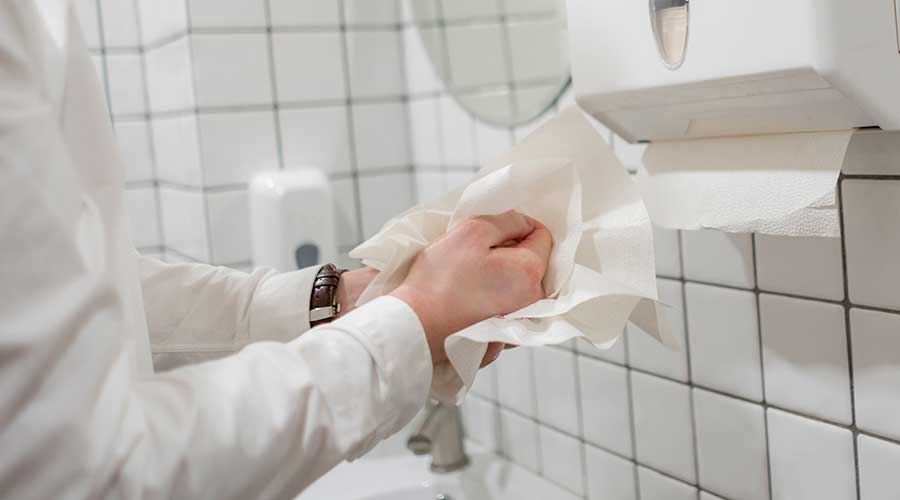Hospitals and other healthcare facilities are bracing themselves for an upcoming so-called twindemic as flu season begins and the COVID-19 pandemic rages on. There have been more calls for people to get vaccinated for both viruses this winter, but another way people can continue to protect themselves is by washing their hands.
“Prior to the COVID-19 pandemic, conversations around hand hygiene focused almost exclusively on hand washing as a general way to stay healthy, particularly during cold and flu season,” says Julie Howard, vice president and general manager of GP PRO’s Towel and Napkin categories. “But when COVID-19 was in its early stages, GP PRO, global and national health organizations and many others worked diligently to communicate that while hand washing is a critical component of proper hand hygiene, so is reducing the number of potentially germy touchpoints individuals come in contact with and drying hands completely after washing them. As a result, COVID-19 was really a singular global event that put a spotlight on touchless towel dispensers, taking them from what was previously a ‘nice to have’ to a ‘need to have’ due to the significant hygiene benefits they offer.”
The U.S. Centers for Disease Control and Prevention and local public health organizations have placed an increased priority on frequent, thorough hand washing as a personal protection behavior in order to defend against contracting an illness. Because of the pandemic, people have been washing their hands more frequently. Effective hand washing includes thoroughly drying hands.
Related Content: How Towel Dispensers Can Prevent Spread of Infections
Paper towels have been used more frequently since the onset of the pandemic. In 2020 and 2021, demand surged for touchless dispensers so people did not have to touch manul dispensers. Meanwhile, people also feared contracting the virus via surfaces and used more hand towels as an additional protective barrier on high-touch surfaces like doorknobs, door pulls and handrails. With less staff, environmental services managers had to rely on products that were more efficient. Dispensers with larger capacities and that were easier to refill and maintain also became more popular.
“Hand towel dispensers should be viewed as essential tools needed to provide a safe, hygienic environment for patients, staff and guests as they are integral in the elimination of one of the links in the chain of infection,” says Marika White, Tork Hygiene Advisor, Essity. “Towels can also assist in the removal of dirt and pathogens from surfaces and serve as a protective barrier when engaging with a high-touch surface. In addition, we should not forget the importance of utilizing innovative towel dispensers in patient rooms.
“When selecting a dispenser, it is important to take into consideration ease of use and how quiet it is so that it does not interfere with the patient’s healing process. Patients need to rest comfortably and not be disturbed by power or battery-operated dispensers. Having a quiet, hygienic environment improves a hospital’s survey scores, which helps generate more revenue.”
One drawback to paper towel dispensers is that they are often seen as harmful toward the environment. But automated, touchless paper towel dispensers can help reduce paper use and waste. By dispensing a pre-set amount of paper towel, touchless dispensers remove the need for users to continually pump a paddle or grab a handful of unneeded paper towels.
“Roll paper towel dispensers eliminate wasteful dispensing of paper towels,” says Alan Gettelman, vice president external affairs with Bobrick Washroom Equipment. “Roll paper towel dispensers dispense a pre-set length of paper towel. Users of folded paper towel dispensers frequently grab more towels than necessary. Dispensing universal, non-proprietary paper towel products is the most cost-effective way to reduce paper towel expenses.
“Building management has the freedom to select and purchase paper towel products at the most competitive price and terms from the supplier of their choice if the consumable paper towel is not restricted by the towel dispensers’ dispensing mechanism operation. This freedom of choice helps to avoid the high prices of consumable contracts common to closed systems. Non-proprietary dispensing of universal paper towels, roll or folded, saves over 30 percent on the cost of paper towels.”
Mackenna Moralez is the associate editor for the facilities market.

 UF Health Hospitals Rely on Green Globes to Realize Their Full Potential
UF Health Hospitals Rely on Green Globes to Realize Their Full Potential How Healthcare Facilities Can Be Truly Disaster-Resilient
How Healthcare Facilities Can Be Truly Disaster-Resilient TriasMD Breaks Ground on DISC Surgery Center for San Fernando Valley
TriasMD Breaks Ground on DISC Surgery Center for San Fernando Valley Bigfork Valley Hospital Falls Victim to Data Breach
Bigfork Valley Hospital Falls Victim to Data Breach AI-Driven Facilities: Strategic Planning and Cost Management
AI-Driven Facilities: Strategic Planning and Cost Management